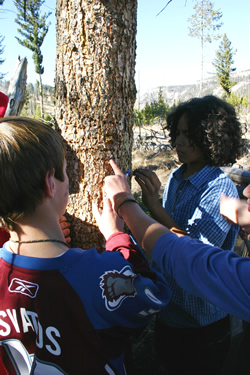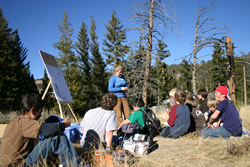
National Fire Plan Success Story
Students Learn Fire Ecology through Place-based Learning
Yellowstone National Park, Wyoming and Montana
National Fire Plan - Accountability
2008

Sixth-grade students take a close look at holes left behind by woodpeckers looking for beetles.

TSS graduate student Sarah Fuller posts her group's research findings from their fire ecology research at Yellowstone National Park.
Did the 1988 fires really devastate Yellowstone? What has regenerated? How is the landscape different? These are some questions 100 students from Gardiner and Bozeman, Montana, answered after participating in an intensive three-day fire ecology and management program with Teton Science Schools (TSS), the National Park Service, and the U.S. Forest Service.
TSS graduate students spent one day in the classroom, teaching basic fire behavior and ecology as well as explaining methods for vegetation monitoring the students would use the next day. On day two, the students went to a field site to conduct fire effects monitoring of a burned area from the 1988 North Fork Fire near Mammoth.
“It was the perfect teaching site, since it had easily accessible, high- and low-intensity burns,” said Samuel Singer, TSS graduate student faculty. “The students saw firsthand the effects of the 1988 fires.”
Along with identifying lodgepole pine, Douglas fir and spruce trees, students learned how fire affects each tree species and about other fire-adapted species. TSS graduate students also took advantage of the bus ride from Bozeman to Mammoth to continue teaching.
“It was great to have the instructors on the bus, working with the kids,” said 6th-grade teacher Wendy Pierce. “Usually the bus ride is just to be endured, but this time kids were learning and using that time educationally (as well as having fun!). The instructors knew how to combine research with games and teaching moments that keyed into the children’s natural curiosity. For many students this was either their first time to the park, or off the road and boardwalks in the park. I have always been unsure how to collect data with a large group of kids, so it was really interesting to watch the teaching techniques.”
In the classroom, the students did activities from the FireWorks trunk, such as the matchstick forest, which shows how tight canopies and slope affect fire behavior. They concluded with a fire management role-playing exercise, where students learned management alternatives to traditional full fire suppression. The students from Gardiner also made a podcast about wildland fire [no longer online].
Contact: Traci Weaver, Fire Communication and Education Specialist, (307) 739-3692.